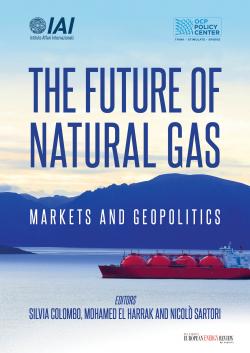The Future of Natural Gas. Markets and Geopolitics
L’energia è al centro di importanti trasformazioni in atto nell’economia e nella geopolitica mondiali, e il gas ha un ruolo cruciale in questi processi. In un contesto caratterizzato dal rapido evolversi dei mercati e delle dinamiche di attori regionali e globali, il volume The Future of Natural Gas intende analizzare il ruolo del gas nel futuro mix energetico, prendendo in considerazione diversi importanti aspetti: le ambiziose politiche per il clima su cui si è accordata la comunità internazionale, la questione dei prezzi e il ruolo dell’innovazione tecnologica nello scenario mondiale del gas. Partendo da questa analisi, il volume adotta poi un approccio geografico per tener conto del significativo variare dei mercati del gas in una prospettiva globale. Si concentra sui principali sviluppi nei paesi e nelle regioni che sono tra i maggiori fornitori e consumatori di gas, considerandone i fattori geologici, gli sviluppi della politica interna e del quadro normativo, l’evolversi dei modelli di consumo, nonché le strategie di esportazione e importazione del gas elaborate dai principali attori a livello regionale e mondiale. Il volume The Future of Natural Gas offre dunque un’analisi approfondita di quei mercati del gas che si stanno oggi trasformando velocemente, cercando di definire le tendenze di una risorsa che nei prossimi decenni avrà un ruolo decisivo nel disegno dell’economia mondiale e delle dinamiche geopolitiche.
Risultati del progetto "The Future of Gas Markets", condotto nell'ambito della partnership strategica IAI-OCP Policy Center. Presentato al seminario internazionale "The Future of Natural Gas: Markets and Geopolitics" organizzato a Rabat il 27 maggio 2016.
List of Contributors, p. 9-10
List of Abbreviations, p. 11-14
Foreword, p. 17-18
Introduction, by Lorenzo Colantoni, Silvia Colombo, Lilia Rizk and Nicolò Sartori, p. 19-24
1. The Future of Gas: The Transition Fuel?, by Luca Franza, Dick de Jong and Coby van der Linde, p. 25-40
1.1 The Case for Natural Gas as a Transition Fuel: Energy per Carbon Matters
1.2 The Failure of Policy-Making in Promoting Gas as a Transition Fuel
1.3 The Perception of Gas as a Politicised Commodity
Conclusions
2. On the Future of Global LNG Trade and Geopolitics, by Chi-Kong Chyong, p. 41-61
2.1 Evolution of LNG Trade and Pricing
2.2 Spot and Short-term LNG Trade
2.3 Short-term Limits to Inter-Regional LNG Trade and Global Gas Market Integration
2.4 Future LNG Developments and Implications for International Trade and Geopolitics
Conclusions
3. The United States as a New Gas Exporter, by David Koranyi, p. 63-78
3.1 US Natural Gas Production Potential
3.2 US Natural Gas Demand
3.3 Natural Gas Exports from the US
3.4 The Political and Regulatory Environment
3.5 Global LNG and Gas Market Developments
3.6 US LNG Export Competitiveness and Export Destinations
3.7 Energy Security Considerations in Europe and Asia
Conclusions
4. Gas in South America: Resources, Corridors and Policies, by Gonzalo Escribano, p. 79-99
4.1 Resources
4.2 Corridors
4.3 Gas Policies
4.4 Looking Ahead
5. The EU and LNG as a Flexible Tool for Energy Security: Constraints and Opportunities, by Giacomo Luciani, p. 101-116
5.1 The Global LNG Market: Developments and Perspectives
5.2 LNG in European Gas Supplies
5.3 The Commission’s Proposed LNG Strategy
Conclusions
6. Eastern Mediterranean Gas: Source of Prosperity for the Region?, by Ayla Gürel, p. 117-138
6.1 Eastern Mediterranean Gas Potential
6.2 Gas Discoveries and Development
6.3 Regional Political and Maritime Disputes
6.4 Markets for Eastern Mediterranean Gas
Conclusions
7. Western Mediterranean Gas: Towards North-South Convergence or Increasing Competition?, by Houda Ben Jannet Allal, p. 139-158
7.1 Natural Gas Demand Is Booming in the Western Mediterranean Region
7.2 Natural Gas Supply in the Western Mediterranean Region
7.3 Natural Gas Trade in the Western Mediterranean Region
7.4 Western Mediterranean Gas: Driver for North-South Convergence and Win-Win Cooperation
8. Winds of Change. Challenging Future for Russia’s Gas, by Agata Łoskot-Strachota, p. 159-179
8.1 Potential: Russian Gas Reserves and Production
8.2 Russian Gas on the Domestic Market
8.3 Decreasing Role of the CIS Market
8.4 Europe and Turkey
8.5 Challenges and Changes in Gas Trade with Europe
Conclusions
9. Sub-Saharan Africa: A Future Global Gas Player?, by Philippe Copinschi and Mark Smedley, p. 181-205
9.1 The Evolution of the Hydrocarbon Industry in West Africa
9.2 East Africa: A New Frontier for the Gas Industry
Conclusions
10. Asia’s Natural Gas and LNG Market Trends, by Wenran Jiang, p. 207-222
10.1 Asia’s Thirst for Natural Gas and LNG
10.2 Impact of the Oil Price Decline on Asian Gas Dynamics
10.3 China’s Gas and LNG Strategies
10.4 China-Russia Cooperation
10.5 Other Regional Dynamics
10.6 Prospects for Market and Policy
11. The Evolution of Japan’s LNG Strategies and Their Geopolitical Implications, by Jane Nakano, p. 223-238
11.1 The Growth of Natural Gas in the Japanese Energy System
11.2 The Fukushima Nuclear Accident and Natural Gas Renaissance
11.3 Diversifying the Supplier Country Pool
11.4 Diversifying LNG Procurement Models
11.5 Domestic Factors Influencing the Future of Gas in Japan
11.6 Blessing and Curse of Low Oil Prices
11.7 Geopolitical Developments Affecting Japanese LNG Strategies
Conclusions
Tema
Tag
Contenuti collegati
-
Evento17/05/2016
The Future of Natural Gas. Markets and Geopolitics
leggi tutto -
Ricerca02/12/2015
The Future of Gas Markets
leggi tutto




